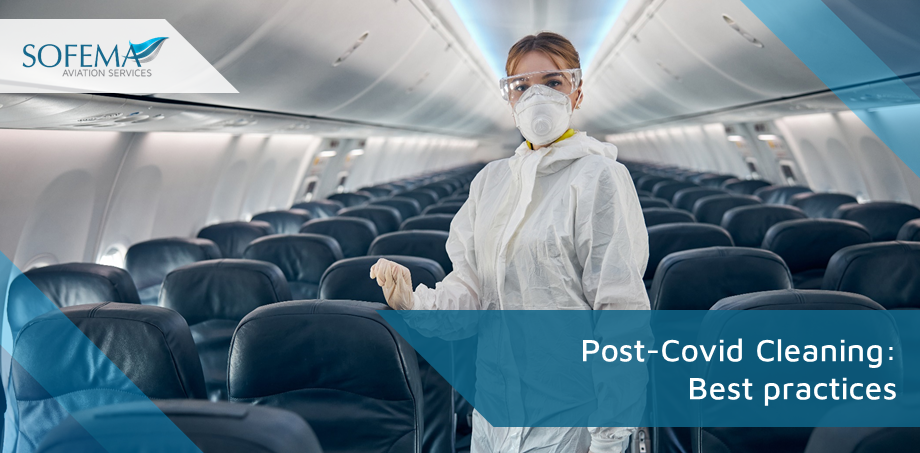Sofema Aviation Services (SAS) www.sassofia.com considers the best cleaning practices compliant with EASA expectations.
The main goal is to disinfect all passenger aircraft. The aircraft’s size and ground time should be considered. Cleaning and disinfection should align with the Aircraft Maintenance Manual (AMM).
Note – The aircraft operator should review and approve each cleaning and disinfecting product.
- They should consider the national public health authorities list and the manufacturer’s recommendations, typically found in the AMM.
Recommended Practices:
- Use separate cleaning tools for different areas, possibly using colour-coding, to prevent cross-contamination.
- Ensure no damage to aircraft components. Surfaces should be wet with disinfectant for the entire contact time and then removed.
- Disinfect the floor from front to back, then vice versa before other cleaning tasks.
Clean thoroughly before disinfecting:
- Clean and disinfect from top (ceiling) to bottom (floor), moving from cleaner to dirtier areas.
Key Areas for Cleaning:
- Aisles: Ceiling, overhead bins, reading lights, air-supply nozzles, sidewall panels, windows, seats, cabinets, bulkheads, magazine racks, cabin crew seats.
- Lavatories: Disinfect from clean to dirty areas, including ceiling, sidewalls, toilet bowls, waste bins, basins, and door assembly.
- Galleys: Ceiling, ovens, water boilers, coffee makers, facilities, lockers, waste bins.
- Flight crew compartment: Clean thoroughly before flight preparation. Preventive disinfection is needed after layovers in SARS-CoV-2 transmission areas. Cleaning should be done by trained staff.
- Cabin: Clean and disinfect all surfaces, equipment used for pre-flight safety demonstration, communication equipment, cabin crew seat harnesses, interphones, passenger seats, and seat belt buckles. Cleaning methods vary based on seat material.
– Frequently touched cabin equipment, such as interphones, should be thoroughly cleaned and disinfected before and after every flight and, if necessary, during the flight. Approved disinfectants/sanitisers should be available for the purpose.
– All passenger seats and seat belt buckles should be thoroughly cleaned and disinfected. The cleaning procedure should be adjusted depending on the material used for the seat/seat covers, for example:
- Woven Fabrics – Seat Covers need to be removed and either dry-cleaned or machine-washed to eliminate the risk of transmission to safe levels.
- Whilst the top surfaces may be able to be cleaned, the woven nature of the product means that the bottom layer and section where the yarns intersect cannot be sufficiently cleaned or disinfected without the removal of the dress cover.
- Leather – Genuine leather has a wipe-clean surface but should only be cleaned with mild soap or surfactant solution to avoid irreparable damage to the product. Genuine leather cannot be dry-cleaned or machine-washed.
- Coated Fabrics (e.g. synthetic leather) – provided the product has a polycarbonate top coat, the following preventive disinfection should be considered:
– Clean the seat cover using an approved cleaning solution and/or vacuum cleaner to remove any foreign objects or debris and clean the surface.
– Using one of the approved disinfection products, apply the disinfection product and allow it to sit on the surface as per the manufacturer’s recommended dwell time.
– After the dwell time, wipe the surface down with a damp cloth to remove a residual disinfectant.
– Items that are frequently used should be cleaned and disinfected, including overhead stowage compartment handles, passenger control units, and touch-screen monitors.
- Oxygen and Emergency Equipment: If used, they should be cleaned and disinfected after the flight.
Safety Precautions:
- Remove any harmful residual disinfection substances from surfaces, especially those that can irritate or harm the skin.
- Disinfection should follow a systematic approach: from the outer ring to the centre, top-down, and all-around.
- Documentation: Cleaning and disinfection activities should be recorded using operator-approved documentation.
Next Steps
Follow this link to our Library to find & download related documents for Free.
Please see the following training course: Aircraft Servicing, Cleaning, and Detailing – 2 Days. For questions or comments please email team@sassofia.com
Tags:
Aircraft Cleaning, Aircraft Maintenance, aviation safety, best practices, Cleaning Practices, Covid, COVID-19, EASA, Pandemic, Post-Covid, SAS blogs, SAS training




